Related Research Articles

The cell is the basic structural and functional unit of all forms of life. Every cell consists of cytoplasm enclosed within a membrane, and contains many macromolecules such as proteins, DNA and RNA, as well as many small molecules of nutrients and metabolites. The term comes from the Latin word cellula meaning 'small room'.

A microorganism, or microbe, is an organism of microscopic size, which may exist in its single-celled form or as a colony of cells.
In biology, a kingdom is the second highest taxonomic rank, just below domain. Kingdoms are divided into smaller groups called phyla.
In biological taxonomy, a domain, also dominion, superkingdom, realm, or empire, is the highest taxonomic rank of all organisms taken together. It was introduced in the three-domain system of taxonomy devised by Carl Woese, Otto Kandler and Mark Wheelis in 1990.
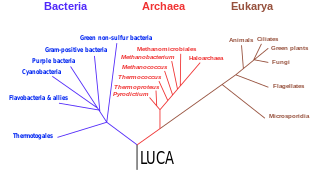
The three-domain system is a taxonomic classification system that groups all cellular life into three domains, namely Archaea, Bacteria and Eukarya, introduced by Carl Woese, Otto Kandler and Mark Wheelis in 1990. The key difference from earlier classifications such as the two-empire system and the five-kingdom classification is the splitting of Archaea from Bacteria as completely different organisms. It has been challenged by the two-domain system that divides organisms into Bacteria and Archaea only, as Eukaryotes are considered as a clade of Archaea.

A unicellular organism, also known as a single-celled organism, is an organism that consists of a single cell, unlike a multicellular organism that consists of multiple cells. Organisms fall into two general categories: prokaryotic organisms and eukaryotic organisms. Most prokaryotes are unicellular and are classified into bacteria and archaea. Many eukaryotes are multicellular, but some are unicellular such as protozoa, unicellular algae, and unicellular fungi. Unicellular organisms are thought to be the oldest form of life, with early protocells possibly emerging 3.8–4.0 billion years ago.
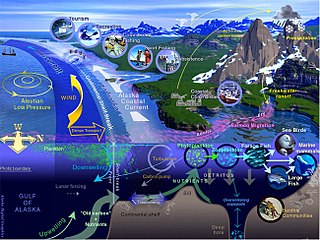
Marine life, sea life, or ocean life is the plants, animals, and other organisms that live in the salt water of seas or oceans, or the brackish water of coastal estuaries. At a fundamental level, marine life affects the nature of the planet. Marine organisms, mostly microorganisms, produce oxygen and sequester carbon. Marine life, in part, shape and protect shorelines, and some marine organisms even help create new land.

Biology is the scientific study of life. It is a natural science with a broad scope but has several unifying themes that tie it together as a single, coherent field. For instance, all organisms are made up of cells that process hereditary information encoded in genes, which can be transmitted to future generations. Another major theme is evolution, which explains the unity and diversity of life. Energy processing is also important to life as it allows organisms to move, grow, and reproduce. Finally, all organisms are able to regulate their own internal environments.

Monera is historically a biological kingdom that is made up of prokaryotes. As such, it is composed of single-celled organisms that lack a nucleus. It has been superseded by the three-domain system.

A prokaryote is a single-cell organism whose cell lacks a nucleus and other membrane-bound organelles. The word prokaryote comes from the Ancient Greek πρό 'before' and κάρυον 'nut, kernel'. In the two-empire system arising from the work of Édouard Chatton, prokaryotes were classified within the empire Prokaryota. But in the three-domain system, based upon molecular analysis, prokaryotes are divided into two domains: Bacteria and Archaea. Organisms with nuclei are placed in a third domain, Eukaryota.
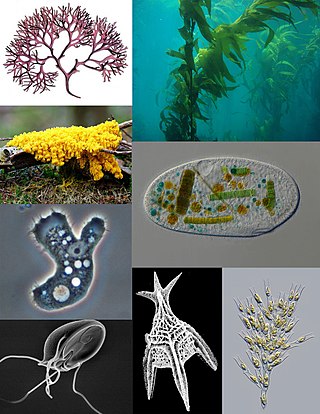
A protist or protoctist is any eukaryotic organism that is not an animal, plant, or fungus. Protists do not form a natural group, or clade, but are a polyphyletic grouping of several independent clades that evolved from the last eukaryotic common ancestor.

Protozoa are a polyphyletic group of single-celled eukaryotes, either free-living or parasitic, that feed on organic matter such as other microorganisms or organic debris. Historically, protozoans were regarded as "one-celled animals".

Archaea is a domain of single-celled organisms. These microorganisms lack cell nuclei and are therefore prokaryotes. Archaea were initially classified as bacteria, receiving the name archaebacteria, but this term has fallen out of use.

The eukaryotes constitute the domain of Eukarya, organisms whose cells have a membrane-bound nucleus. All animals, plants, fungi, and many unicellular organisms are eukaryotes. They constitute a major group of life forms alongside the two groups of prokaryotes: the Bacteria and the Archaea. Eukaryotes represent a small minority of the number of organisms, but given their generally much larger size, their collective global biomass is much larger than that of prokaryotes.

Marine microorganisms are defined by their habitat as microorganisms living in a marine environment, that is, in the saltwater of a sea or ocean or the brackish water of a coastal estuary. A microorganism is any microscopic living organism or virus, that is too small to see with the unaided human eye without magnification. Microorganisms are very diverse. They can be single-celled or multicellular and include bacteria, archaea, viruses and most protozoa, as well as some fungi, algae, and animals, such as rotifers and copepods. Many macroscopic animals and plants have microscopic juvenile stages. Some microbiologists also classify viruses as microorganisms, but others consider these as non-living.
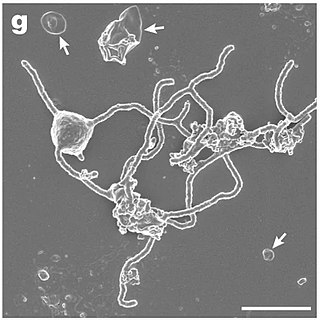
Lokiarchaeota is a proposed phylum of the Archaea. The phylum includes all members of the group previously named Deep Sea Archaeal Group, also known as Marine Benthic Group B. Lokiarchaeota is part of the superphylum Asgard containing the phyla: Lokiarchaeota, Thorarchaeota, Odinarchaeota, Heimdallarchaeota, and Helarchaeota. A phylogenetic analysis disclosed a monophyletic grouping of the Lokiarchaeota with the eukaryotes. The analysis revealed several genes with cell membrane-related functions. The presence of such genes support the hypothesis of an archaeal host for the emergence of the eukaryotes; the eocyte-like scenarios.
The initial version of a classification system of life by British zoologist Thomas Cavalier-Smith appeared in 1978. This initial system continued to be modified in subsequent versions that were published until he died in 2021. As with classifications of others, such as Carl Linnaeus, Ernst Haeckel, Robert Whittaker, and Carl Woese, Cavalier-Smith's classification attempts to incorporate the latest developments in taxonomy., Cavalier-Smith used his classifications to convey his opinions about the evolutionary relationships among various organisms, principally microbial. His classifications complemented his ideas communicated in scientific publications, talks, and diagrams. Different iterations might have a wider or narrow scope, include different groupings, provide greater or lesser detail, and place groups in different arrangements as his thinking changed. His classifications has been a major influence in the modern taxonomy, particularly of protists.
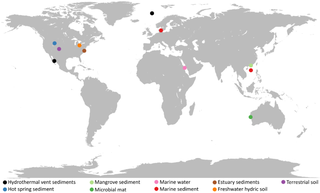
Asgard or Asgardarchaeota is a proposed superphylum consisting of a group of archaea that contain eukaryotic signature proteins. It appears that the eukaryotes, the domain that contains the animals, plants, and fungi, emerged within the Asgard, in a branch containing the Heimdallarchaeota. This supports the two-domain system of classification over the three-domain system.

The evolution of bacteria has progressed over billions of years since the Precambrian time with their first major divergence from the archaeal/eukaryotic lineage roughly 3.2-3.5 billion years ago. This was discovered through gene sequencing of bacterial nucleoids to reconstruct their phylogeny. Furthermore, evidence of permineralized microfossils of early prokaryotes was also discovered in the Australian Apex Chert rocks, dating back roughly 3.5 billion years ago during the time period known as the Precambrian time. This suggests that an organism in of the phylum Thermotogota was the most recent common ancestor of modern bacteria.

Marine prokaryotes are marine bacteria and marine archaea. They are defined by their habitat as prokaryotes that live in marine environments, that is, in the saltwater of seas or oceans or the brackish water of coastal estuaries. All cellular life forms can be divided into prokaryotes and eukaryotes. Eukaryotes are organisms whose cells have a nucleus enclosed within membranes, whereas prokaryotes are the organisms that do not have a nucleus enclosed within a membrane. The three-domain system of classifying life adds another division: the prokaryotes are divided into two domains of life, the microscopic bacteria and the microscopic archaea, while everything else, the eukaryotes, become the third domain.
References
- ↑ "life form". World English Dictionary. Dictionary.com. 2009.
- ↑ "life form". Online Oxford Dictionary of English. Oxford University Press. 2005. Archived from the original on 2011-08-11.
- ↑ Kunin, W.E.; Gaston, Kevin, eds. (31 December 1996). The Biology of Rarity: Causes and consequences of rare—common differences. ISBN 978-0412633805 . Retrieved 26 May 2015.
- ↑ Stearns, Beverly Peterson; Stearns, S. C.; Stearns, Stephen C. (2000). Watching, from the Edge of Extinction. Yale University Press. p. preface x. ISBN 978-0-300-08469-6 . Retrieved 30 May 2017.
- ↑ Novacek, Michael J. (8 November 2014). "Prehistory's Brilliant Future". New York Times . Retrieved 2014-12-25.
- ↑ "Are we alone in the universe?". NASA. March 1, 2022. Retrieved July 12, 2022.